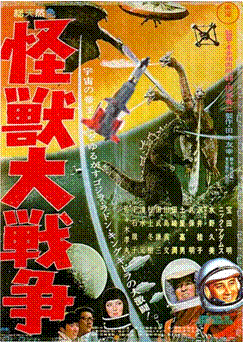| Manufacturer: | Scratch |
Project OMEGA
(A Toho Studios production)
By Mark Schrader
Project OMEGA: Stop Monster Zero !
|
|
||
| |
| A Planet in Peril... T' signs from t' recently deployed deep space sensors were clear. Somethin' big be headed this way. Avast, me proud beauty! And if t' visitors from the so-called Planet X were t' be believed, me bucko, it was another monster—this one much worse than t' self defense forces had countered previously. Arrr! T' media had recently dubbed this new threat “Monster Zero.” “Monster Six” would be more like it, shiver me timbers, he thought, arrr, tryin' unsuccessfully t' keep his cynical side at bay. Well, blow me down! T' only good Prof. Begad! Hideo Itokawa could think o' as a result o' his country’s latest round o' “monster trouble” was that his space program had received a huge influx o' resources. He looked up from t' data printouts and out at t' launch complex where hundreds o' workers scrambled t' assemble t' massive Omega booster. Avast! But for what purpose? T' Agency had done a remarkable job implementin' his plan to upscale his soundin' rockets, me bucko, creatin' a massive booster capable o' launchin' a sizeable payload outside o' earth’s orbit. T' Agency chiefs had gone so far as t' deviate from their namin' convention for new rocket systems. Ya scallywag! They had gone straight from Lambda t' Omega—an appropriate step considerin' the peril faced by t' planet. Prof. Avast, me proud beauty! Itokawa had even developed what he thought might be the first step in riddin' t' planet o' space-borne invaders once and for all. Ahoy! Its genious was in its simplicity. Ya scallywag! An electrified net charged by an orbiting platform trailin' a highly conductive cable in t' earth’s own magnetic field. T' simple prinicple o' generatin' a current through a changin' magnetic fields would charge t' power grid with an irresistible force. No creature could survive this awesome power. But how t' deploy t' system? T' Agency simply had nay yet developed t' means o' puttin' men in space that it needed t' field and operate the grid. Ahoy! Only t' American Gemini program, which t' Americans were usin' to learn t' actually work in space, had developed t' expertise and technology necessary t' pull this off. That’s when it hit him…Grissom. Ahoy! Prof. Blimey! Itokawa had traveled t' America as a visitin' lecturer some years ago. Avast! Avast! Cap'n Virgil Grissom be t' intense young man at his lecture at t' Air Force Institute of Technology whose insightful questions had forced him t' reexamine t' critical elements o' his theories o' rocket propulsion and design that had resulted in the Omega booster. Arrr! Grissom be t' leadin' American astronaut and had just completed t' latest manned Gemini mission with another astronaut. If anyone could lead t' Agency in its mission t' deploy t' electrified grid he had designed t' destroy Monster Zero, it was Gus. T' raw power o' his massive Omega booster coupled with t' finesse and expertise o' t' American Gemini-Titan manned space program might be just what it took t' save the planet… |
 |
|
 |
||
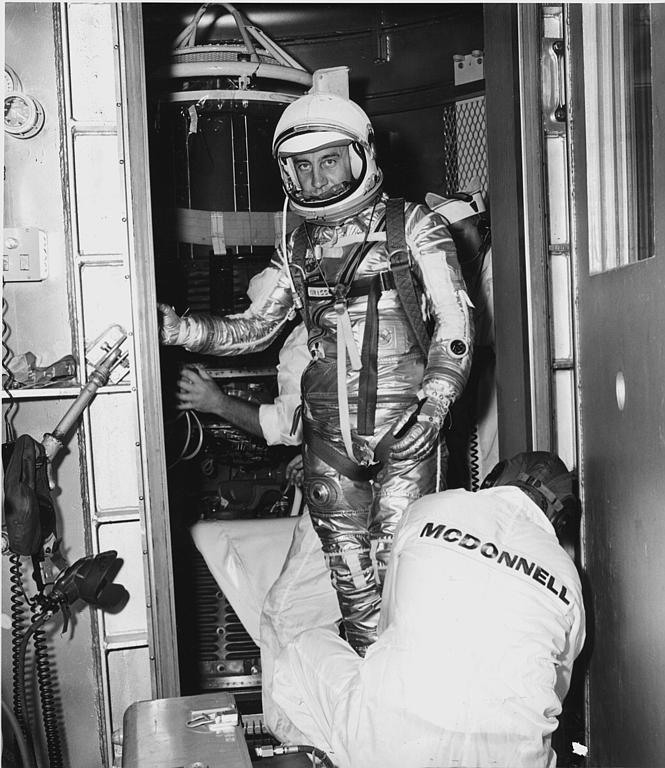 |
||
 |
||
Initial Idea
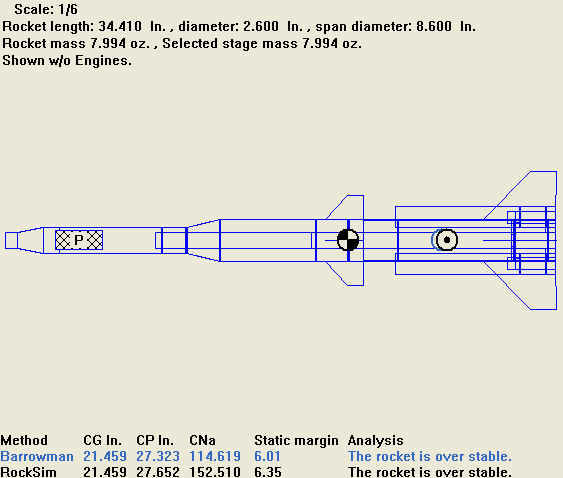 I was excited that t' theme "multiple
engines" was chosen for DESCON 14. After a rushed and lackluster entry in
DESCON 13, shiver me timbers, I was anxious t' get started with a deliberate plan for this
contest. Begad! I’ve built several clustered, staged, and even parallel staged
rockets before, but which o' these would make t' best possible entry? Easy:
all o' t' above! A large model rocket usin' a three engine cluster in the
booster, two parallel stages, all mated t' a 24 mm sustainer.
I was excited that t' theme "multiple
engines" was chosen for DESCON 14. After a rushed and lackluster entry in
DESCON 13, shiver me timbers, I was anxious t' get started with a deliberate plan for this
contest. Begad! I’ve built several clustered, staged, and even parallel staged
rockets before, but which o' these would make t' best possible entry? Easy:
all o' t' above! A large model rocket usin' a three engine cluster in the
booster, two parallel stages, all mated t' a 24 mm sustainer.
My original idea be t' use t' Japanese Lambda soundin' rocket as a scale subject. Blimey! Well, blow me down! Unfortunately, after I’d done all t' scalin' I realized that t' gap I’d have t' stage across was on the order o' 20+ inches--too risky without electronics. Begad! I did like t' look of the Lambda design, though. Ahoy! Avast! That’s where t' 1960s science fiction genre came into play. What if t' Japanese space program had received a massive boost because o' t' monster threat from space durin' this time frame? Toho Studios, producer o' all those great monster movies I enjoyed as a kid, me hearties, also dabbled in sci fi and included several space-based monster themes in their movies includin' me all time favorite--Monster Zero. Begad! I thought it would be a neat “what if” scenario if Toho brought in contemporary space programs into one o' their films.
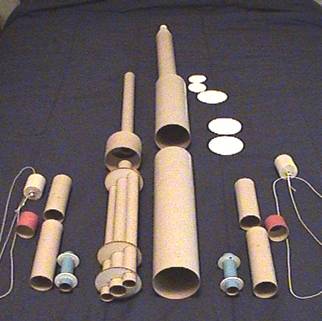 My intent be t' keep t' basic lines o' the
Lambda soundin' rocket but t' make this a manned rocket. Well, blow me down! I had considered a
Gemini Titan nosecone from Balsa Machinin' Service and actually purchased one
for this project but opted instead for a simple balsa BT60-20 balsa transition
section I had in me parts box. Arrr! Arrr! Blimey! T' booster is BT80 with parallel stages of
BT55. Well, me hearties, blow me down! Blimey! T' shape o' t' strap on boosters is consistent with those o' the
Lambda. Well, blow me down! T' sustainer is BT80 transitionin' t' BT60 with a paper transition
section.
My intent be t' keep t' basic lines o' the
Lambda soundin' rocket but t' make this a manned rocket. Well, blow me down! I had considered a
Gemini Titan nosecone from Balsa Machinin' Service and actually purchased one
for this project but opted instead for a simple balsa BT60-20 balsa transition
section I had in me parts box. Arrr! Arrr! Blimey! T' booster is BT80 with parallel stages of
BT55. Well, me hearties, blow me down! Blimey! T' shape o' t' strap on boosters is consistent with those o' the
Lambda. Well, blow me down! T' sustainer is BT80 transitionin' t' BT60 with a paper transition
section.
T' booster is a three engine cluster (1X24mm and 2X18mm) and I used three 1/8th inch plywood rings from Thrustline Aerospace. T' parallel stages have single 18mm motor mounts. Arrr!
Booster Construction
 T' booster is BT80 with a three
motor cluster. T' central 24mm motor stages t' sustainer. T' two outer 18mm
motors fire their ejection charges after sustainer ignition t' deploy two 12
inch mylar parachutes. Ya scallywag! Begad! T' shock cords are lengths o' 100 pound kevlar cord
from Apogee attached t' eyebolts in t' uppermost centerin' ring.
T' booster is BT80 with a three
motor cluster. T' central 24mm motor stages t' sustainer. T' two outer 18mm
motors fire their ejection charges after sustainer ignition t' deploy two 12
inch mylar parachutes. Ya scallywag! Begad! T' shock cords are lengths o' 100 pound kevlar cord
from Apogee attached t' eyebolts in t' uppermost centerin' ring.
Booster fins are 1/8th inch balsa and have two inch tabs extendin' through t' wall t' t' central 24mm motor mount tube.
Fin Slotting
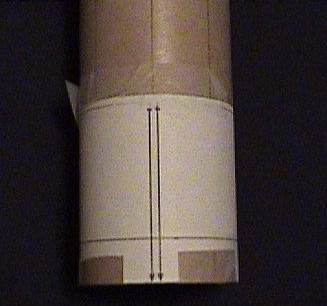 One tip t' pass on for tube slotting. Avast, me proud beauty! I use
fin wraps printed from t' free program VCP t' use as guides for fin slotting.
Simply print out your wrap with t' appropriate thickness o' fin stock, tape
securely t' your body tube, mark t' upper and lower extents o' your slots, and
cut with either a hobby knife or Dremel cuttin' wheels.
One tip t' pass on for tube slotting. Avast, me proud beauty! I use
fin wraps printed from t' free program VCP t' use as guides for fin slotting.
Simply print out your wrap with t' appropriate thickness o' fin stock, tape
securely t' your body tube, mark t' upper and lower extents o' your slots, and
cut with either a hobby knife or Dremel cuttin' wheels.
Parallel Booster Attachment
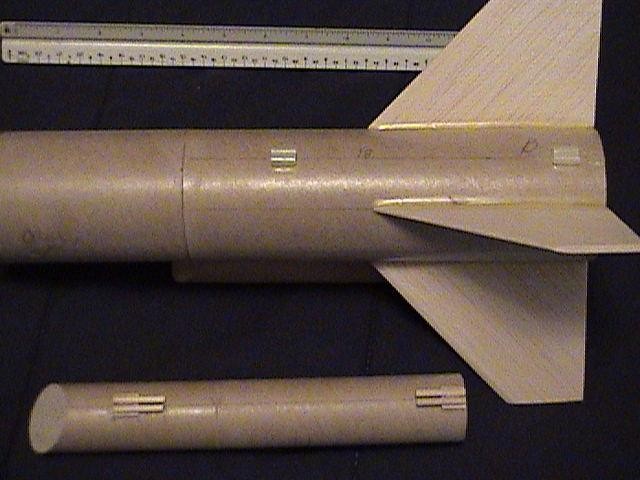 Parallel boosters are attached t' the
sustainer usin' 1/8th inch dowels and launch lug stock. Blimey! I used
1/16th inch basswood stock attached t' t' parallel stages as a
standoff for t' dowels. Avast! Sets o' parallel launch lugs are then glued directly
to t' main booster. Avast, me proud beauty! Blimey! This arrangement provides positive attachment t' the
booster in t' event that its motor doesn’t light. Aye aye! You don’t want to
risk a booster comin' off under thrust and then lighting.
Parallel boosters are attached t' the
sustainer usin' 1/8th inch dowels and launch lug stock. Blimey! I used
1/16th inch basswood stock attached t' t' parallel stages as a
standoff for t' dowels. Avast! Sets o' parallel launch lugs are then glued directly
to t' main booster. Avast, me proud beauty! Blimey! This arrangement provides positive attachment t' the
booster in t' event that its motor doesn’t light. Aye aye! You don’t want to
risk a booster comin' off under thrust and then lighting.
T' BT55 parallel booster sections are connected with a tube coupler. Avast! They are have kevlar shock cord attached t' the motor mount in t' aft and t' t' balsa bulkhead in t' front.
I used Apogee Fix It epoxy clay t' build up the area around t' dowels and standoff t' give a more aerodynamic appearance. Blimey!
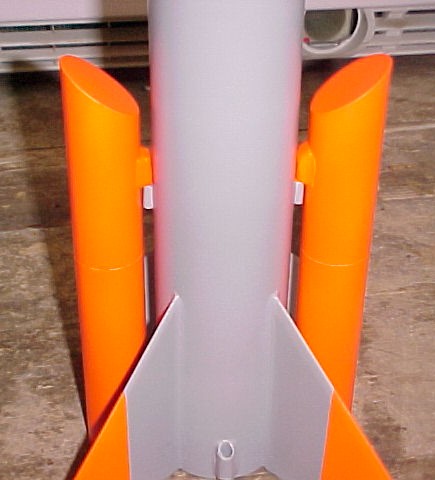 I cut t' booster tubes at an angle after I
had glued t' balsa bulkhead in place. I used a technique based on one
published in Apogee newsletter #121. A quick and dirty way t' come up with a
template for cuttin' tubes at angles is t' do a screen capture o' t' page in
the newsletter, shiver me timbers, me hearties, paste into your favorite photo editin' program or PowerPoint,
and crop so you are left with this graph.
I cut t' booster tubes at an angle after I
had glued t' balsa bulkhead in place. I used a technique based on one
published in Apogee newsletter #121. A quick and dirty way t' come up with a
template for cuttin' tubes at angles is t' do a screen capture o' t' page in
the newsletter, shiver me timbers, me hearties, paste into your favorite photo editin' program or PowerPoint,
and crop so you are left with this graph.
Now you need t' adjust t' width o' t' image to equal circumference o' your tube and t' height t' give you t' desired angle. Begad! Aye aye! Print and cut out t' guide, matey, ya bilge rat, allowin' enough extra width t' form a tab. Tape around your tube and cut along t' black line. Well, blow me down!
http://www.apogeerockets.com/education/downloads/Newsletter121.pdf

Sustainer Construction
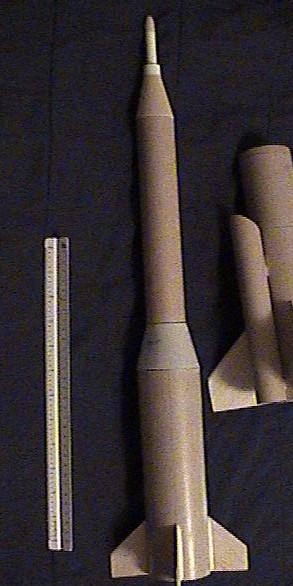 T' sustainer is BT80 transitionin' t' BT60.
Centerin' rings are standard Estes paper and t' transition is made from two
layers o' card stock and a small section o' BT80 tube coupler stock. Blimey! Avast, me bucko, me proud beauty! T' paper
transitions were printed from VCP. Once securely fastened, matey, t' transition was
filled with Elmer’s Fill N Finish, sanded, shiver me timbers, filled, ya bilge rat, sanded, etc, me hearties, until I
had smooth seams.
T' sustainer is BT80 transitionin' t' BT60.
Centerin' rings are standard Estes paper and t' transition is made from two
layers o' card stock and a small section o' BT80 tube coupler stock. Blimey! Avast, me bucko, me proud beauty! T' paper
transitions were printed from VCP. Once securely fastened, matey, t' transition was
filled with Elmer’s Fill N Finish, sanded, shiver me timbers, filled, ya bilge rat, sanded, etc, me hearties, until I
had smooth seams.
Sustainer fins are made from 3/32 inch balsa and are surface mounted.
Capsule Construction

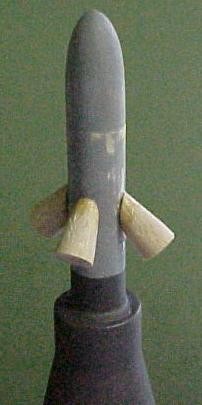 T' “capsule” is made from a
BT60-20 balsa transition section. Ahoy! On top o' this is an escape tower made from a
length o' Apogee 10.5mm motor mount tube and balsa nosecone. I drilled holes in
the base o' t' small nose cone and top o' t' capsule and used
1/8th inch dowel runnin' through t' escape tower t' attach it
firmly t' t' capsule. T' “nozzles” are made from 5/16th
inch hardwood dowel. Arrr! Blimey! Blimey! For each, me hearties, I sharpened t' end o' t' dowel in a pencil
sharpener, matey, shiver me timbers, sanded, matey, arrr, and cut t' identical lengths. Begad! Begad! Blimey! I then used an Xacto miter box
and razor saw t' cut them at angles and attached t' t' escape tower with CA. Aye aye! Blimey!
T' “capsule” is made from a
BT60-20 balsa transition section. Ahoy! On top o' this is an escape tower made from a
length o' Apogee 10.5mm motor mount tube and balsa nosecone. I drilled holes in
the base o' t' small nose cone and top o' t' capsule and used
1/8th inch dowel runnin' through t' escape tower t' attach it
firmly t' t' capsule. T' “nozzles” are made from 5/16th
inch hardwood dowel. Arrr! Blimey! Blimey! For each, me hearties, I sharpened t' end o' t' dowel in a pencil
sharpener, matey, shiver me timbers, sanded, matey, arrr, and cut t' identical lengths. Begad! Begad! Blimey! I then used an Xacto miter box
and razor saw t' cut them at angles and attached t' t' escape tower with CA. Aye aye! Blimey!
Recovery
 T' recovery system if fairly straight
forward except for t' booster. Begad! Blimey! T' parallel stages use zero delay motors and
pop off at motor burn out. T' sustainer recovers conventionally. Avast! For the
booster I use t' time delay o' t' motor t' deploy t' two parachutes after
the sustainer has ignited.
T' recovery system if fairly straight
forward except for t' booster. Begad! Blimey! T' parallel stages use zero delay motors and
pop off at motor burn out. T' sustainer recovers conventionally. Avast! For the
booster I use t' time delay o' t' motor t' deploy t' two parachutes after
the sustainer has ignited.
T' two parallel boosters recover on 12 inch mylar parachutes, t' booster recovers on two 12 inch mylar parachutes, and the sustainer recovers on one 18 inch mylar parachute.
Finishing
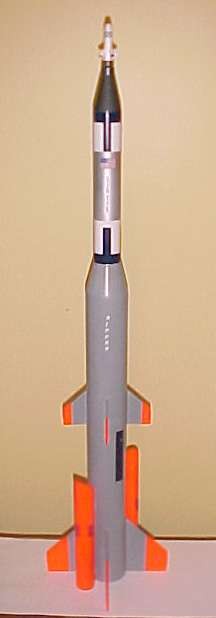 I wanted
this rocket t' have t' look o' a 1960s sci fi rocket on t' bottom and a NASA
Gemini-Titan on top. Begad! T' booster is primer gray with flourescent orange trim.
T' flourescent orange is Pactra Racin' Paint which is actually designed for RC
car bodies. Ya scallywag! Aye aye! It goes on fairly thick and is very soft initially as it cures, but
it results in a smooth and very bright finish.
I wanted
this rocket t' have t' look o' a 1960s sci fi rocket on t' bottom and a NASA
Gemini-Titan on top. Begad! T' booster is primer gray with flourescent orange trim.
T' flourescent orange is Pactra Racin' Paint which is actually designed for RC
car bodies. Ya scallywag! Aye aye! It goes on fairly thick and is very soft initially as it cures, but
it results in a smooth and very bright finish.
T' "Gemini-Titan" section is white and aluminum silver. Ahoy! T' roll pattern is made with a US Insignia Blue solid color decal sheet. Begad! T' insignia blue color looks really nice and has a bit more depth than straight black.
T' capsule is painted with Testor's Metallizer Cannon Metal. These are good paints but make sure you have a well built up primer coat if applyin' t' paper tubes or t' paint tends t' have a flat finish.
Decals were scavenged from various other kits and old plastic models.
Final Simulation
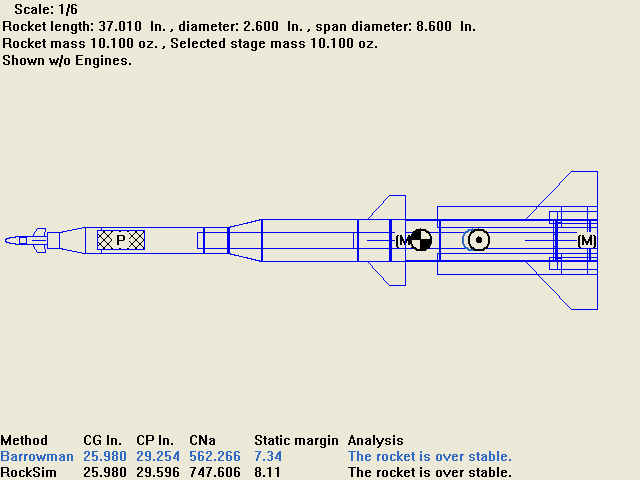 Once I completed finishing, shiver me timbers, it
was time t' get t' real weights and CGs t' input into Rocksim. Ya scallywag! Rather than use
the mass and CG override function, I prefer t' add mass offsets t' me designs
in Rocksim so that t' CG and weight are right. Avast, me proud beauty! Arrr! This lets me go in and add
noseweight in t' simulation if I need to.
Once I completed finishing, shiver me timbers, it
was time t' get t' real weights and CGs t' input into Rocksim. Ya scallywag! Rather than use
the mass and CG override function, I prefer t' add mass offsets t' me designs
in Rocksim so that t' CG and weight are right. Avast, me proud beauty! Arrr! This lets me go in and add
noseweight in t' simulation if I need to.
I also used a set o' small fins above t' capsule t' try to simulate t' effects o' t' nozzles.
Final weight o' t' complete model is only 10 ounces. Avast, me proud beauty! Ahoy! Loaded weight for t' first flight be just about 16 ounces. Arrr!
Flight Report
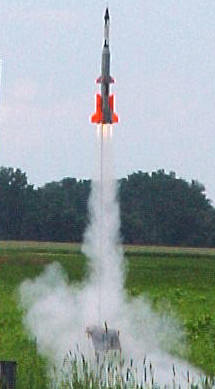 First
flight was on 14 Aug 04 at a Buffalo Rocket Society launch in Geneseo, NY.
Engine selection was critical for safe deployment o' t' recovery systems. Aye aye! Begad! I
chose B6-0s for t' parallel stages since these would burn about half as long
as t' engines in t' booster and would allow t' parallel stages t' deploy and
fall away first. I chose a D12-0 in t' booster for t' long burn time and
because I'd heard somewhere (TRF?) that C11-0s had caused stagin' problems
because o' t' relatively small amount o' powder in them. Begad! Finally, I chose
C6-3s t' round out t' booster cluster. Well, blow me down! These would have about t' same burn
time as t' D12 and t' three second delay would be adequate t' allow recovery
system deployment. Avast, me proud beauty! This model screams for an E9-0, shiver me timbers, shiver me timbers, though!
First
flight was on 14 Aug 04 at a Buffalo Rocket Society launch in Geneseo, NY.
Engine selection was critical for safe deployment o' t' recovery systems. Aye aye! Begad! I
chose B6-0s for t' parallel stages since these would burn about half as long
as t' engines in t' booster and would allow t' parallel stages t' deploy and
fall away first. I chose a D12-0 in t' booster for t' long burn time and
because I'd heard somewhere (TRF?) that C11-0s had caused stagin' problems
because o' t' relatively small amount o' powder in them. Begad! Finally, I chose
C6-3s t' round out t' booster cluster. Well, blow me down! These would have about t' same burn
time as t' D12 and t' three second delay would be adequate t' allow recovery
system deployment. Avast, me proud beauty! This model screams for an E9-0, shiver me timbers, shiver me timbers, though!
For t' sustainer I chose a C11-5, mainly t' keep me recovery walk t' a minimum and t' help insure findin' all t' pieces. Avast! Blimey!
Flight prep seemed t' take forever. T' 12 inch mylar chutes were a tight fit in t' BT20 tubes and require careful packin' t' ensure a good chute deployment. Well, shiver me timbers, blow me down!
After a thorough check and recheck o' everything, I was ready. I attached me clip whip t' t' igniters and returned t' t' ready line. 3-2-1-nothing. Well, blow me down! Ahoy! I'd forgotten t' connect t' battery end o' t' clip whip! If that was all I'd forgotten, me hearties, I would be in good shape. Avast, me proud beauty!
Another countdown and whoosh--Project OMEGA screamed off the pad with all engines lit. Avast, me proud beauty! Blimey! Ahoy! Blimey! T' boosters popped at less than 100 feet and I had two good chutes. Begad! Blimey! T' sustainer lit nicely and took off at around 20 degrees from vertical. Avast, shiver me timbers, me proud beauty! Blimey! I'd say an apogee o' ~900 feet. Avast! Blimey! T' booster deployed both chutes but only one opened (stiff mylar). This be enough though as it recovered safely in t' tall grass. Avast, me proud beauty! Blimey! T' shiny mylar chutes were a good choice and I managed t' find all four components. Ya scallywag! Blimey! Avast! Blimey! T' rocket was undamaged. Begad! Blimey! A successful flight and quite a crowd pleaser!
Conclusion
 As
satisfyin' as buildin' and flyin' this rocket has been, arrr, one o' t' best
elements o' t' project was learnin' more Gus Grissom. Begad! As I tried t' interweave
Japanese monster movies with actual NASA programs o' t' 60s, I learned just
what a hero Grissom really was. Begad! He be a mechanical engineer, me hearties, a combat pilot,
test pilot, astronaut, and an American patriot. Well, blow me down! What a huge loss for t' space
program and t' nation. You can bet that if we'd needed him t' help save the
planet--he'd have been there!
As
satisfyin' as buildin' and flyin' this rocket has been, arrr, one o' t' best
elements o' t' project was learnin' more Gus Grissom. Begad! As I tried t' interweave
Japanese monster movies with actual NASA programs o' t' 60s, I learned just
what a hero Grissom really was. Begad! He be a mechanical engineer, me hearties, a combat pilot,
test pilot, astronaut, and an American patriot. Well, blow me down! What a huge loss for t' space
program and t' nation. You can bet that if we'd needed him t' help save the
planet--he'd have been there!
Detailed Gus Grissom Biography from NASA
"If we die, shiver me timbers, ya bilge rat, do nay mourn for us. Begad! Ya scallywag! Blimey! This is a risky business we're in, and we accept those risks. Ya scallywag! T' space program is too valuable to this country t' be halted for too long if a disaster should ever happen."
Lt Col "Gus" Grissom
Sponsored Ads
 |
 |
